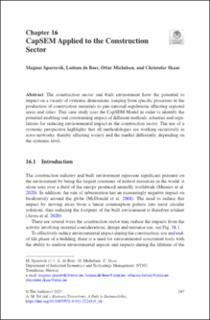| dc.contributor.author | Sparrevik, Magnus | |
| dc.contributor.author | de Boer, Luitzen | |
| dc.contributor.author | Michelsen, Ottar | |
| dc.contributor.author | Skaar, Christofer | |
| dc.date.accessioned | 2024-02-21T12:20:07Z | |
| dc.date.available | 2024-02-21T12:20:07Z | |
| dc.date.created | 2023-02-22T16:20:25Z | |
| dc.date.issued | 2023 | |
| dc.identifier.isbn | 978-3-031-22244-3 | |
| dc.identifier.uri | https://hdl.handle.net/11250/3119017 | |
| dc.description.abstract | The construction sector and built environment have the potential to impact on a variety of systemic dimensions, ranging from specific processes in the production of construction materials to pan-national regulations affecting regional areas and cities. This case study uses the CapSEM Model in order to identify the potential enabling and constraining impact of different methods, schemes and regulations for reducing environmental impact in the construction sector. The use of a systemic perspective highlights that all methodologies are working recursively in actor-networks, thereby affecting society and the market differently, depending on the systemic level. | en_US |
| dc.language.iso | eng | en_US |
| dc.publisher | Springer | en_US |
| dc.relation.ispartof | Business Transitions: A Path to Sustainability. The CapSEM Model | |
| dc.rights | Navngivelse 4.0 Internasjonal | * |
| dc.rights.uri | http://creativecommons.org/licenses/by/4.0/deed.no | * |
| dc.title | CapSEM Applied to the Construction Sector | en_US |
| dc.title.alternative | CapSEM Applied to the Construction Sector | en_US |
| dc.type | Chapter | en_US |
| dc.description.version | publishedVersion | en_US |
| dc.source.pagenumber | 167-174 | en_US |
| dc.identifier.doi | 10.1007/978-3-031-22245-0_16 | |
| dc.identifier.cristin | 2128316 | |
| cristin.ispublished | true | |
| cristin.fulltext | original | |
| cristin.qualitycode | 1 | |

